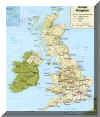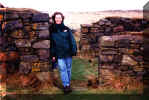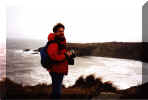|
Welcome to Scotland! |
|
|
|
|
1st Trip: Edinburgh and the East Coast - New Years 1999/2000 Having been in Germany for six months, we were desperate to hear English and lots of it! We decided to spend the New Year, 31 December 1998 through 5 January 1999, in Scotland. We made arrangements to fly into Edinburgh and stay on the quiet Scottish East coast in the city of Aberdeen for a couple of days. We then made plans to stay in Edinburgh the remainder of the trip. Our itinerary ensured that we would see some of both the Lowlands and the Highlands; Edinburgh being in the Lowlands, Aberdeen in the Highlands. For those of you who do not know, Scotland is divided up into two separate regions, the Lowlands, and the Highlands and Islands, each having spoken different, traditional languages. Scots was originally spoken in the Lowlands. This was a form of Middle English and is now extinct. Gaelic was spoken in the Highlands and Islands and is still used today. On New Year's Eve, we caught an early morning fight out of Düsseldorf and landed in Edinburgh. We were picked up at the airport by a rental car representative. It was on the drive to the car agency that we realized we would have understood the young representative better had he been speaking German rather than English. His accent was really thick and his English was almost unrecognizable. Our drive was filled with lots of "pardons" and "ummms." We were scared...real scared! Our first experience driving in Scotland was pretty white knuckle. Eddie, never having driven on the "wrong" side of the road before, readily volunteered to take the wheel. Sheena was a little nervous for Eddie (and herself), remembering how confusing it was the first time she drove on the wrong side of the rode when she was stationed in Japan with the US Air Force. And Eddie getting in on the wrong side of the car right off the bat didn't ease her nerves. Eddie did great and managed to become an expert at the round-abouts. It also helped that the British transportation department tells you which way to look when you get to a Stop sign. Directions are located right on the road in big, white letters. Right out of Edinburgh we decided to take the coastal drive to Aberdeen. The weather was beautiful and somewhat sunny. We crossed over the Firth of Forth and made our way towards Arbroath. We stopped in Arbroath and wondered an outdoor strip mall and had lunch, all the while basking in the English signs and being able to understand completely what those around us were saying—we discovered that the rental car representative's accent was not the norm. After lunch we decided to visit the Arbroath Abbey, one of the few sites open during the holiday season. This Benedictine abbey was built in 1178. The abbey was pretty much in ruins with mainly walls standing and a couple of buildings still intact. The founder of the abby, King Wiliam the Lion of Scotland, is buried here. The abbey also played an important part in Scottish history when a letter to Pope John XXII, the "Declaration of Arbroath," was signed in 1320 by noblemen and clergy. This Declaration resulted in Robert the Bruce becoming king. The rest of the drive was spectacular. Once in Aberdeen, we found our hotel. We stayed at the lovely Craiglynn Hotel. The hotel and the owners were absolutely wonderful and very accomodating. They even made us a special New Year's Eve dinner. After dinner, we walked around the town and enjoyed seeing the town's men going to various parties dressed in the beautiful traditional kilts. Sheena really thought about going up to one of them and asking whether it was true that they don't wear anything under the kilts...needless to say, common sense won out and she didn't pursue this idea any further. (Sheena did, however, get the opportunity to ask this question of her Scottish co-workers in Paris in 2003...they laughingly told her that the answer was a national secret to which only the men of Scotland are privy! Of course, she didn't let the subject drop and tried to persuade them to tell her anyway, but to no avail...it is still a mystery.) On New Year's Day, we celebrated by getting up early and heading out for a hike along the North Sea. It was a little hard getting used to the limited daytime hours of 10:00 to 14:00 (2 PM), and we tried to make the most of the glowing daylight as possible. We drove north to the Forvie National Nature Reserve. Forvie is the fifth largest sand dune system in Britain and the one least disturbed by people. It also has the largest breeding colony of eider ducks in Britain and is one of the best examples of coastal heathland in Scotland. The highest point of the reserve is 171 feet (57 m) above sea level. We followed the trail along the coast and then wound our way inland back to our car. To our delight, we discovered that along the steep parts of the trail actual stairways had been built, and over the marshy areas, raised walkways had been built. It was a beautiful and fun hike. We really had to bundle up, however, because the wind off of the North Sea was blowing fiercely and it was very cold. Along the walk, we came across several archaeological points of interest. The Sands of Forvie have been described as an archaeological site second to none on the coast of eastern Scotland. 4-5,000 years ago, late bronze or early iron age people traveled to this area, leaving behind the numerous archaeological sites. After we explored every nook and cranny of the park, we headed back into Aberdeen for a quiet evening. Because almost all of the restaurants and fast food places were closed for the day, we decided to settle into a local hotel and had dinner. The next day, we took a drive along the north coast and circled back to Aberdeen. The road we took is the road usually taken by tourists in large buses. We were amazed and very thankful that we decided to take this drive during the off-season. The road was barely wide enough for our compact car much less an oversized tourist bus, and had no shoulders and lots of marshy drop-offs. We drove along the coast and through the towns of Peterhead, Fraserburgh, Banff, Cullen, and Buckie. We stopped periodically and walked around archaeological sites, lighthouses, and marinas. We stopped in Cullen and had lunch at the Cullun Bay Hotel. The view from the hotel was incredible, sitting on a cliff overlooking the North Sea and Cullen Bay. We soon headed back to Aberdeen via the inland road. The sights were breathtaking and the towns picturesque. On January 3rd, we set out for Edinburgh via the Royal Deeside route. This route took us past several castles and through several little towns. We drove past Balmoral Castle, the Queen's favorite Scottish retreat, but didn't get a chance to see it. We did stop in the town of Braemar, which caters to the castle and its occupants. It was really interesting to see the royal crest on the shops where the royal family regularly shops. After a long day of driving and siteseeing in the Highlands, we managed to arrive in Edinburgh at night. Big mistake! Unbeknownst to us, the street names in Edinburgh change with almost every block. This is because they had so many people to honor that the only way to do so was to name each block differently...what a nightmare! It took us forever to find our bed and breakfast. For dinner, we decided to try something a little different and walked to a nearby Nepalese restaurant. The restaurant was small, dark, and crowded, with tables in very close proximity of each other. We were lucky and had a table that was up against the wall and that had a little ledge to put things on. We had a terrific meal and bottle of wine, and the wait staff were very nice and accommodating. The next day we set out on our walking tour of Edinburgh. Edinburgh is widely regarded as one of Europe's handsomest capitals. It is very striking with its medieval and Georgian districts, and is famous for the arts. Of course, it also has the premier shopping district of England, the Royal Mile: Castle Hill to High Street. It is a stretch of four ancient streets that formed the main thoroughfare of medieval Edinburgh. We shopped High Street and bought a couple of cashmere sweaters and enjoyed window shopping. It was extremely windy that day, as a storm was blowing in from the sea. It was so windy that we saw both men and women being pushed along the sidewalks, with a few having to stop and grab a lamppost to keep themselves from being blown off of their feet. We witnessed one Japanese woman trying to cross the street to the shopping mall...we thought she was going to be swept off of her feet never to bee seen again, because she was so petite. She eventually made it, much to our delight and amazement. Sheena even struggled considerably with walking...it was the strongest wind Edinburgh had experienced so far that winter. Of course, we toured Edinburgh Castle that day...the highlight of the city. It is an assemblage of building dating from the 12th to the 20th-century, and dominates the city while providing stunning views of Edinburgh and the surrounding countryside. The castle has had many roles, including fortress, royal palace, military garrison, and state prison. It is now the permanent headquarters of the Royal Scots regiment and home to the Scottish National War Memorial for those who died during W.W. I. The Honours of the Kingdom exhibition is also at the castle. The exhibition traces the history of the Scotland's Crown jewels and culminates in a visit to the jewels, which are spectacular. While on the grounds, we toured St. Margaret's Chapel, which was built in 1090 and is believed to be the oldest building in Edinburgh. We also toured the Royal Palace and saw the chamber where James VI was born to Mary Stuart, Queen of Scots. He later became James I of England, King. The Castle was a very interesting place to visit and we really enjoyed the time we spent there learning more about the history of Scotland and its people. The next day we caught our flight back to Düsseldorf on a small, Belgian airline, Sabena. We had to change planes in Brussels, which was thoroughly exciting! In Europe, most airports use a bussing system. You get off the plane, walk onto the tarmac, and onto a waiting bus. The bus then drives to the terminal doors where you get off and continue on to your next destination. For us, that was security and immigration because we were flying in from Great Britain, which is not a member of the European Union. The line at security was extra long and took forever. By the time we got our passports stamped, we had 10 minutes to make our connecting flight. Imagine this...Eddie and Sheena loaded with heavy carry-ons (purchases we had made) and coats running through the airport for what seemed like forever, dodging people, hurtling large women, and leaping luggage to catch our connecting flight to Düsseldorf...it's true...it happened! When we got to the gate and onto the plane, we realized that this particular airline waits for all registered passengers and will not leave until every last one is on board...you think they would have told us that before we got off the first plane!? We also realized that our connecting plane was parked right next to the plane we had just gotten off of! Red-faced, sweating profusely, and breathing heavily, we look at each other in total dismay. Thus ended our first trip to Scotland.
Cheers, |
|
|||||||||||||||
|
|
|||||||||||||||||

 The flag of the United Kingdom
The flag of the United Kingdom


